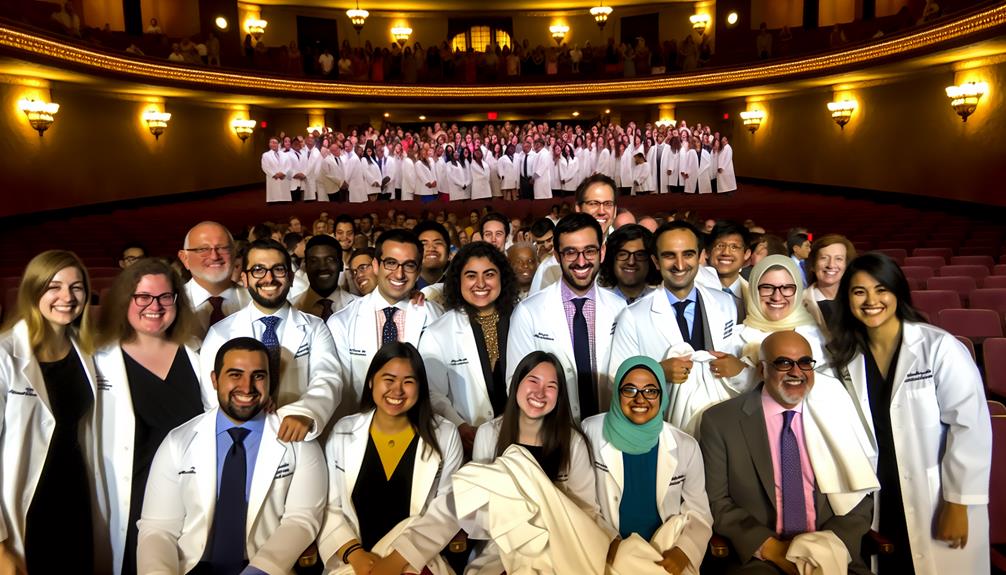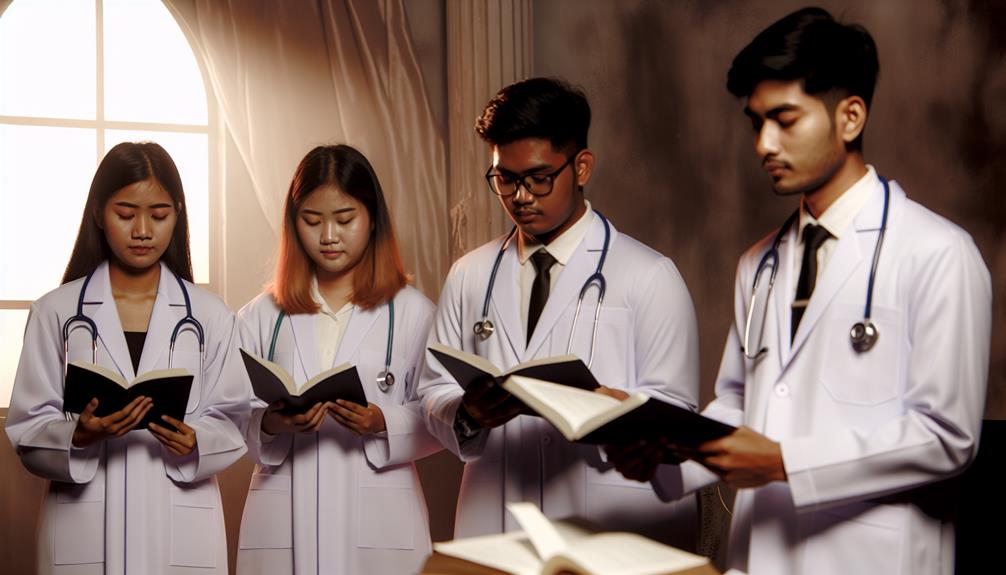The White Coat Ceremony is a significant milestone for new medical students, symbolizing their entry into the medical profession and the ethical responsibilities that accompany it. Originating in 1993, this rite of passage emphasizes professionalism, empathy, and a commitment to patient care. During the ceremony, students don their white coats and often recite the Hippocratic Oath, reflecting on their aspirations and obligations. This event fosters a sense of community among peers and reinforces the importance of mentorship. The emotional impact of such ceremonies creates lasting bonds and prepares students for future challenges in their medical careers. Discover more about its profound significance.
Key Takeaways
- The White Coat Ceremony symbolizes the commitment to patient care, professionalism, and the ethical standards of the medical profession.
- Originating in 1993, the ceremony has evolved into a formal rite of passage, emphasizing professionalism and empathy in medical education.
- The event fosters a sense of belonging among students, reinforcing their identity as future healthcare professionals and their responsibilities towards patients.
- Faculty and mentors play a crucial role in guiding students, fostering resilience, and enhancing professional development through personalized support and mentorship.
- Community and peer support are vital, promoting collaborative learning, emotional resilience, and a positive atmosphere essential for academic success in medical training.
Meaning of the White Coat

The white coat symbolizes the profound responsibilities and ethical standards inherent in the medical profession. Worn by medical students and practitioners alike, this garment serves as a powerful emblem of medical identity, signifying a commitment to patient care, professionalism, and the pursuit of knowledge. The importance of establishing this identity early in one's career can be likened to the benefits of early saving, which lays a foundation for future financial stability. The white coat is not merely a uniform; it represents a pledge to uphold the values of compassion, integrity, and diligence in the face of challenges.
The white coat symbolism extends beyond aesthetics, fostering a sense of belonging within the medical community. For new medical students, donning the white coat during their ceremony marks a pivotal change into a world where they will be entrusted with the health and well-being of others. This momentous occasion is an affirmation of their dedication to the rigorous demands of medical training and the ethical implications of their future roles.
As students wear their coats with pride, they are reminded of the significance of empathy in their practice. The white coat, consequently, is not only a sartorial choice but a profound statement of purpose, uniting future physicians in their endeavor to make impactful contributions to society.
Historical Background
The White Coat Ceremony has its origins in the late 20th century, established to symbolize the shift of medical students into the profession. This ceremony is often complemented by educational resources that enhance academic preparedness, such as effective study tools which help students excel in their studies. Over the years, the ceremony has evolved to incorporate elements of professionalism, ethics, and empathy, reflecting the changing landscape of medical education. Today, it holds significant cultural impact, serving as a rite of passage that emphasizes the responsibilities and values inherent in the practice of medicine.
Origins of the Ceremony
Emerging from a rich tapestry of medical tradition, the White Coat Ceremony marks a pivotal moment in the journey of aspiring physicians. The ceremony's origins can be traced back to the late 20th century, specifically in 1993 at the University of Chicago Pritzker School of Medicine. This event was designed to bridge the gap between the academic environment and the clinical responsibilities that students would soon face.
The historical significance of the White Coat Ceremony lies in its emphasis on professionalism, empathy, and ethical practice, reminding new medical students of the weight of the white coat they are about to don. The act of receiving the coat serves as a tangible symbol of their commitment to patient care and the medical profession, fostering a sense of belonging to a larger community of healers.
As the ceremony gained popularity, medical schools across the globe began to adopt it, celebrating the changeover from classroom learning to patient interaction. This collective experience not only reinforces the values of medicine but also creates a shared bond among students, marking the beginning of their transformative journey in healthcare.
Evolution Over Time
As medical education evolved, the White Coat Ceremony underwent significant changes, reflecting shifting values and priorities within the profession. Originally a simple event, it has transformed into a formal rite of passage that emphasizes the responsibilities and ethical commitments of medical students. The ceremony's growth parallels changing practices in medical training, highlighting the increasing importance of professionalism, empathy, and patient-centered care.
In recent decades, educational trends have also influenced the ceremony's structure and significance. Many medical schools now incorporate reflections on the social contract between physicians and society, encouraging students to contemplate the impact of their future roles. This evolution underscores a broader recognition of the need for future healthcare providers to possess not only clinical skills but also compassion and integrity.
Moreover, the inclusion of family members and mentors in the ceremony fosters a sense of community, reinforcing the idea that medical education is a shared journey. As the White Coat Ceremony continues to adapt, it remains a powerful symbol of the commitment to lifelong learning and the ethical practice of medicine, connecting new students to a rich tradition while guiding them toward their future responsibilities.
Cultural Impact Today
In contemporary society, the White Coat Ceremony has emerged as a significant cultural event, symbolizing the shift of medical students into the ethical and professional domains of healthcare. This rite of passage not only marks the commencement of their medical education but also embodies the values and responsibilities that come with being a healthcare provider. The white coat itself serves as a powerful cultural symbolism, representing purity, professionalism, and the commitment to patient care.
From a global perspective, the White Coat Ceremony is celebrated in various forms across different cultures, highlighting the universal importance of the medical profession. While the specifics may vary, the underlying message remains consistent: new medical students are welcomed into a community dedicated to healing and service. This ceremony fosters a sense of belonging, reinforcing the idea that they are part of a larger mission to improve health outcomes and alleviate suffering.
As these future physicians don their white coats, they not only embrace their roles within healthcare but also acknowledge the trust placed in them by society. The White Coat Ceremony continues to resonate, inspiring generations of medical professionals to uphold the ideals of compassion, integrity, and excellence.
Ceremony Structure

The structure of the White Coat Ceremony is meticulously designed to emphasize the significance of the medical profession and the responsibilities that accompany it. Typically held at the beginning of a medical student's journey, the ceremony format includes formal speeches, the donning of white coats, and the recitation of the Hippocratic Oath. This carefully curated sequence creates a powerful atmosphere of anticipation and commitment. Additionally, similar to how remote customer service roles are structured to support new employees, the ceremony aims to provide guidance and encouragement to students as they commence on their medical careers remote job trends.
Key participant roles include faculty members, who deliver inspiring messages, and current medical students, who often share their experiences, bridging the gap between the new students and their future. The presence of family and friends underscores the communal aspect of the event, reinforcing the support system essential for success in medical education.
The donning of the white coat is a pivotal moment, symbolizing both the beginning of professional training and the ethical responsibilities that come with it. By inviting students to reflect on their aspirations and ethical obligations, the ceremony fosters a sense of belonging within the medical community. Ultimately, the structure of the White Coat Ceremony serves to unite participants, instilling pride and a shared vision for the future as they commence on their medical careers.
Emotional Impact on Students
The White Coat Ceremony not only marks a significant milestone in medical education but also generates profound emotional responses among students. For many, donning the white coat symbolizes a pivotal moment of personal transformation, as they shift from the role of a student to that of a future healthcare professional. This rite of passage often elicits feelings of pride, joy, and anticipation, underscoring the gravity of the journey ahead. As students commence on this journey, they may also face challenges such as stress and emotional strain, making it essential to cultivate coping strategies for resilience recognizing burnout symptoms.
As students receive their coats, they are reminded of the responsibilities that come with their chosen profession. This moment cultivates a sense of belonging to a community dedicated to healing and care, fostering connections that can last a lifetime. The emotional resonance of the ceremony serves as a powerful catalyst for developing emotional resilience, equipping students to face the challenges of medical training and practice.
Ultimately, the White Coat Ceremony is not merely a formal event; it is an experience that profoundly impacts students' identities and aspirations. The shared emotional journey strengthens their commitment to the medical field, reinforcing their resolve to meet the challenges and rewards of a career dedicated to serving others.
Role of Faculty and Mentors

The role of faculty and mentors is pivotal in shaping the experiences of medical students during their training. Their influence can be seen in how they guide students through complex clinical scenarios, much like how P. Diddy has navigated his own career through various challenges and controversies, showcasing the importance of resilience in professional development controversies and comebacks. Through guidance and support, they foster professional relationships that enhance personal and academic growth. Such mentorship not only provides essential knowledge but also instills confidence as students shift into their future roles as healthcare providers.
Faculty Guidance Importance
Effective faculty guidance plays an essential role in shaping the educational journey of medical students. Faculty mentorship provides students with the necessary support and direction to navigate the complexities of medical education. Through tailored guidance strategies, faculty members help cultivate a sense of belonging and community among aspiring physicians.
Key aspects of faculty guidance include:
- Personalized Support: Faculty mentors offer individualized attention, addressing specific academic and emotional needs, which fosters confidence and resilience.
- Professional Development: Mentorship enhances students' understanding of the medical profession, helping them develop essential skills, such as critical thinking, effective communication, and ethical decision-making.
- Networking Opportunities: Faculty members often introduce students to professional connections, opening doors for research, clinical experiences, and future job prospects.
Mentorship Impact on Growth
Mentorship greatly influences the growth and development of medical students, enhancing their educational experiences and personal journeys. Faculty and mentors play a pivotal role in guiding students through the complexities of medical training. By fostering an environment of support, they empower students to navigate challenges, develop clinical skills, and cultivate empathy—essential qualities for future physicians.
Mentorship programs are critical, offering structured opportunities for students to connect with experienced professionals. These programs facilitate knowledge sharing, career guidance, and emotional support, creating a sense of belonging within the medical community. Additionally, peer mentorship serves as a powerful tool, enabling students to learn collaboratively, share experiences, and encourage one another.
Engaging in peer mentorship not only enhances academic success but also builds lasting relationships that contribute to a positive learning atmosphere. As new medical students don their white coats, the bonds formed through mentorship will serve as a foundation for their growth. By embracing the wisdom and experience of mentors, students can develop resilience, confidence, and a greater understanding of their roles in healthcare, ultimately shaping them into compassionate and competent physicians.
Building Professional Relationships
Establishing strong professional relationships with faculty and mentors is essential for the development of medical students. These connections not only enhance learning experiences but also foster a sense of belonging in the medical community. Effective relationship building and strategic networking can greatly impact both academic and professional trajectories.
To cultivate these relationships, consider the following strategies:
- Engage Actively: Participate in faculty-led discussions, workshops, and seminars. Show genuine interest in their work and insights, which encourages meaningful dialogue.
- Seek Guidance: Approach mentors for advice on clinical skills, research opportunities, or career paths. Their experience can provide invaluable perspectives and guidance tailored to your aspirations.
- Follow Up: Maintain communication through emails or meetings after initial interactions. Express gratitude for their time and insights, and keep them informed of your progress and achievements.
Commitment to Patient Care
As medical students shift into their clinical training, their commitment to patient care becomes a fundamental pillar of their professional identity. This pivotal change emphasizes the importance of patient-centered care, where the needs and preferences of patients take center stage in the healing process. Understanding that each patient is a unique individual fosters a compassionate practice, enabling students to connect meaningfully with those they serve.
In this stage of their education, students are encouraged to actively listen, empathize, and advocate for their patients, ensuring that care is tailored to address not just medical needs, but emotional and psychological aspects as well. The cultivation of such skills is essential for building trust and rapport, which are integral to effective healthcare delivery.
Furthermore, embracing a commitment to patient care signifies a dedication to lifelong learning and professional growth. It reinforces the notion that healthcare is not merely a transactional interaction but a partnership aimed at improving health outcomes. As future physicians don their white coats, they are reminded of their responsibility to uphold these values, shaping a healthcare environment that prioritizes compassion, respect, and understanding.
Ethical Standards in Medicine

The foundation of ethical standards in medicine is built upon principles that guide healthcare professionals in their interactions with patients and colleagues. Upholding medical ethics is vital for fostering trust and ensuring that patients receive the highest quality of care. New medical students must embrace these standards as they commence on their professional journey.
To navigate the complexities of medical practice, students should focus on the following key ethical principles:
- Autonomy: Respecting the patient's right to make informed decisions about their own care.
- Beneficence: Committing to act in the best interest of patients, promoting their well-being.
- Justice: Ensuring fairness in the distribution of healthcare resources and access to care.
Community and Peer Support
In medical education, having a supportive community can greatly enhance the student experience and foster resilience. The shift into medical school is challenging, emphasizing the importance of community engagement and peer mentorship. New students benefit immensely from connecting with peers who understand their struggles, as these relationships cultivate a sense of belonging.
| Benefits of Community Support | Examples of Peer Engagement |
|---|---|
| Emotional Resilience | Study Groups |
| Academic Guidance | Mentorship Programs |
| Networking Opportunities | Social Events |
| Stress Relief | Support Groups |
Engaging with fellow students allows individuals to share experiences, resources, and coping strategies. Peer mentorship offers an invaluable opportunity for guidance, as seasoned students can provide insights into maneuvering the rigors of medical education. The collaborative environment fosters not only academic success but also personal growth.
Additionally, community engagement through extracurricular activities can strengthen these bonds, promoting a culture of support that is essential for thriving in medical school. Ultimately, the relationships formed during this critical time can create a lasting network, greatly contributing to the overall well-being of future healthcare professionals.
Future Implications for Students

Building a strong foundation of community support during medical school not only enhances the immediate student experience but also lays the groundwork for future professional relationships and career trajectories. As students navigate their journey, the implications of this support extend beyond graduation, shaping their professional identities and career aspirations.
- Development of Clinical Skills: Engaging with a supportive community fosters collaboration and mentorship, vital for honing clinical skills. This environment encourages students to seek guidance and feedback, enhancing their ability to interact with patients effectively.
- Preparation for Future Challenges: A robust support network helps students build resilience, equipping them to face the inevitable challenges of the medical profession. This prepares them for the demands of work-life balance and the complexities of patient care.
- Commitment to Lifelong Learning: Encouraging a culture of continuous education within their community inspires students to embrace lifelong learning, essential for adapting to evolving medical practices and technologies.
Ultimately, the community built during medical school not only nurtures personal growth but also paves the way for fulfilling careers focused on compassionate patient interactions and professional excellence.
Frequently Asked Questions
What Should Students Wear to the White Coat Ceremony?
When attending the white coat ceremony, students should adhere to formal dress etiquette, as this event symbolizes the shift into the medical profession. Appropriate attire typically includes business professional clothing, such as a suit or dress, which reflects the significance of this milestone. This occasion fosters a sense of belonging within the medical community, and dressing appropriately demonstrates respect for the profession and the commitment to uphold its values as future healthcare providers.
How Long Does the Ceremony Usually Last?
The ceremony duration for events such as the White Coat Ceremony typically spans between one to two hours, depending on the event schedule and institutional traditions. This timeframe allows for meaningful speeches, the actual coat presentation, and opportunities for family and friends to celebrate the achievements of the new medical students. Proper planning guarantees that the ceremony remains engaging while fostering a sense of community and belonging among attendees.
Can Family Members Attend the White Coat Ceremony?
Yes, family members are typically encouraged to attend the white coat ceremony, which underscores the importance of family support during this crucial moment. Their presence not only enhances the emotional significance of the event but also fosters a sense of belonging for the new students. By sharing this experience, families contribute to the holistic development of future medical professionals, reinforcing the essential role of community and support in their educational journey.
Is There a Specific Speaker at the Ceremony?
Typically, the white coat ceremony features a keynote speaker who delivers an inspiring message aimed at motivating new students. This address often encompasses themes of compassion, dedication, and the responsibilities that come with a medical career. The speaker may be a distinguished faculty member, a physician, or a notable figure in the healthcare field. Their insights not only set the tone for the ceremony but also foster a sense of belonging within the medical community.
What Happens to the White Coat After the Ceremony?
After the ceremony, the white coat serves as a powerful symbol of professionalism and commitment in the medical field. It signifies the shift into a new phase of education and responsibilities. Post-ceremony, students are expected to uphold the values associated with the white coat, including empathy, integrity, and dedication to patient care. The coat becomes a reminder of their duty to the community and the importance of lifelong learning in their medical journey.



